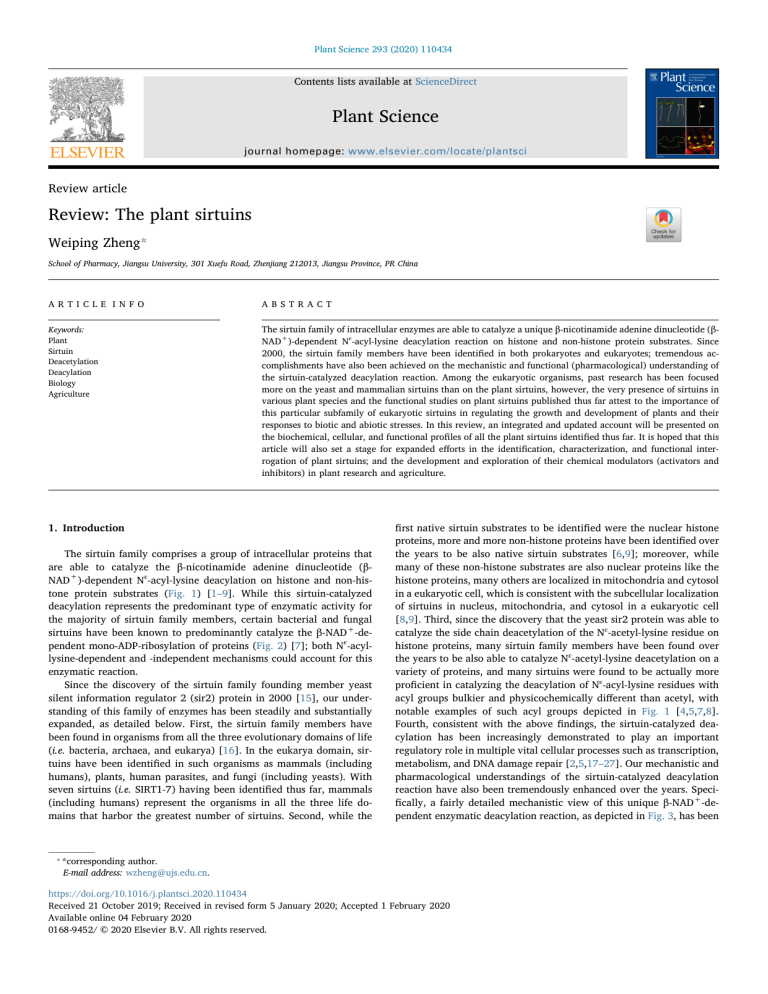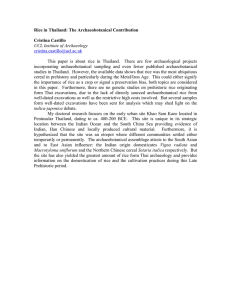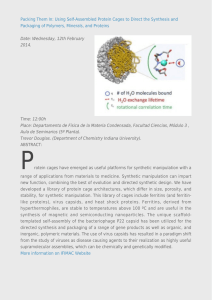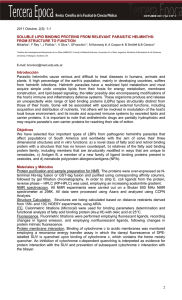
Plant Science 293 (2020) 110434 Contents lists available at ScienceDirect Plant Science journal homepage: www.elsevier.com/locate/plantsci Review article Review: The plant sirtuins T Weiping Zheng* School of Pharmacy, Jiangsu University, 301 Xuefu Road, Zhenjiang 212013, Jiangsu Province, PR China A R T I C LE I N FO A B S T R A C T Keywords: Plant Sirtuin Deacetylation Deacylation Biology Agriculture The sirtuin family of intracellular enzymes are able to catalyze a unique β-nicotinamide adenine dinucleotide (βNAD+)-dependent Nε-acyl-lysine deacylation reaction on histone and non-histone protein substrates. Since 2000, the sirtuin family members have been identified in both prokaryotes and eukaryotes; tremendous accomplishments have also been achieved on the mechanistic and functional (pharmacological) understanding of the sirtuin-catalyzed deacylation reaction. Among the eukaryotic organisms, past research has been focused more on the yeast and mammalian sirtuins than on the plant sirtuins, however, the very presence of sirtuins in various plant species and the functional studies on plant sirtuins published thus far attest to the importance of this particular subfamily of eukaryotic sirtuins in regulating the growth and development of plants and their responses to biotic and abiotic stresses. In this review, an integrated and updated account will be presented on the biochemical, cellular, and functional profiles of all the plant sirtuins identified thus far. It is hoped that this article will also set a stage for expanded efforts in the identification, characterization, and functional interrogation of plant sirtuins; and the development and exploration of their chemical modulators (activators and inhibitors) in plant research and agriculture. 1. Introduction The sirtuin family comprises a group of intracellular proteins that are able to catalyze the β-nicotinamide adenine dinucleotide (βNAD+)-dependent Nε-acyl-lysine deacylation on histone and non-histone protein substrates (Fig. 1) [1–9]. While this sirtuin-catalyzed deacylation represents the predominant type of enzymatic activity for the majority of sirtuin family members, certain bacterial and fungal sirtuins have been known to predominantly catalyze the β-NAD+-dependent mono-ADP-ribosylation of proteins (Fig. 2) [7]; both Nε-acyllysine-dependent and -independent mechanisms could account for this enzymatic reaction. Since the discovery of the sirtuin family founding member yeast silent information regulator 2 (sir2) protein in 2000 [15], our understanding of this family of enzymes has been steadily and substantially expanded, as detailed below. First, the sirtuin family members have been found in organisms from all the three evolutionary domains of life (i.e. bacteria, archaea, and eukarya) [16]. In the eukarya domain, sirtuins have been identified in such organisms as mammals (including humans), plants, human parasites, and fungi (including yeasts). With seven sirtuins (i.e. SIRT1-7) having been identified thus far, mammals (including humans) represent the organisms in all the three life domains that harbor the greatest number of sirtuins. Second, while the ⁎ first native sirtuin substrates to be identified were the nuclear histone proteins, more and more non-histone proteins have been identified over the years to be also native sirtuin substrates [6,9]; moreover, while many of these non-histone substrates are also nuclear proteins like the histone proteins, many others are localized in mitochondria and cytosol in a eukaryotic cell, which is consistent with the subcellular localization of sirtuins in nucleus, mitochondria, and cytosol in a eukaryotic cell [8,9]. Third, since the discovery that the yeast sir2 protein was able to catalyze the side chain deacetylation of the Nε-acetyl-lysine residue on histone proteins, many sirtuin family members have been found over the years to be also able to catalyze Nε-acetyl-lysine deacetylation on a variety of proteins, and many sirtuins were found to be actually more proficient in catalyzing the deacylation of Nε-acyl-lysine residues with acyl groups bulkier and physicochemically different than acetyl, with notable examples of such acyl groups depicted in Fig. 1 [4,5,7,8]. Fourth, consistent with the above findings, the sirtuin-catalyzed deacylation has been increasingly demonstrated to play an important regulatory role in multiple vital cellular processes such as transcription, metabolism, and DNA damage repair [2,5,17–27]. Our mechanistic and pharmacological understandings of the sirtuin-catalyzed deacylation reaction have also been tremendously enhanced over the years. Specifically, a fairly detailed mechanistic view of this unique β-NAD+-dependent enzymatic deacylation reaction, as depicted in Fig. 3, has been *corresponding author. E-mail address: [email protected]. https://doi.org/10.1016/j.plantsci.2020.110434 Received 21 October 2019; Received in revised form 5 January 2020; Accepted 1 February 2020 Available online 04 February 2020 0168-9452/ © 2020 Elsevier B.V. All rights reserved. Plant Science 293 (2020) 110434 W. Zheng tissues/developmental stages and subcellular compartments, which has been demonstrated in multiple studies on the functional roles of the plant sirtuins. The following section will be devoted to a discussion on such reported functional roles which can be mediated by the deacylation of the histone proteins or the non-histone proteins. 3. The functional roles of the plant sirtuin-catalyzed deacylation on histone or non-histone proteins in Arabidopsis, rice, and Phaeodactylum The lysine Nε-acylation/deacylation on core histone proteins that constitute the core histone octamer of the nucleosome, i.e. histone proteins H3, H4, H2A, and H2B, has been an established epigenetic switch whose operation has been demonstrated to play an important role in regulating important cellular processes via gene expression modulation [53,54], since these histone proteins coexist with DNA double helix in nucleosome and therefore the lysine side chain acylation/deacylation on histone proteins and the ensuing changes in the stereoelectronic properties of the modified lysine side chains and their interaction strength with the negatively charged (under physiological pH) DNA double helix would directly modulate the accessibility of the DNA segments on the nucleosome to transcriptional machinery. In specific, acylation would convert a positively charged (under physiological pH) lysine side chain to a neutral acylated lysine side chain, thereby weakening its interaction with the DNA double helix that winds upon the core histone octamer, leading to an activation of the expression of certain genes; on the other hand, deacylation would engender an opposite effect, i.e. a suppression of gene expression. While the lysine residues on histone proteins can be Nε-acylated with enzymatic reactions catalyzed by histone acyltransferases [53,54], the deacylation of the resulting Nε-acyl-lysine residues can be accomplished with the enzymatic reactions catalyzed either by the Zn2+-containing family of deacylases [53,55] or by the β-NAD+-dependent sirtuin family of deacylases [3–5,7,8,53]. Therefore, by participating in a dynamic establishment of the epigenetic lysine Nε-acylation/deacylation switch on histone proteins, the sirtuin-catalyzed deacylation reaction also contributes to a dynamic regulation of various cellular processes via modulating the expression of the genes for other cellular proteins such as those involved in cellular metabolism. A unique feature of the sirtuin-catalyzed deacylation reaction is its β-NAD+-dependence, therefore, this enzymatic reaction can be regulated by the cellular metabolic status that can impact the intracellular β-NAD+ concentration. Theoretically speaking, histone proteins can be the native substrates for the plant sirtuins recorded in Table 1 with a nuclear localization, which has been experimentally demonstrated for several plant sirtuins. In Arabidopsis thaliana [37], studies with the AtSRT1 wild-type, knock-down, and over-expression plant lines revealed that the nuclear sirtuin AtSRT1 exhibited a suppressive action toward glycolysis via repressing the expression of the genes and thus the activities of certain enzymes of the glycolytic pathway, mediated by the catalytic deacetylation of the K9-acetylated histone protein H3 (H3K9ac) at the promoter regions; these enzymes include hexokinase (HK), pyruvate kinase (PK), phosphofructose kinase (PFK), and enolase. Moreover, the AtSRT1-catalyzed deacetylation of H3K9ac at the promoter regions of ZAT10, LOS2, RD29A, and RD29B led to a repression of the expression of these four stress-responsive genes, resulting in an attenuated tolerance to the phytohormone abscisic acid (ABA) treatment (a type of abiotic stress) and NaCl and mannitol treatments (salt and osmotic stresses, respectively, another two types of abiotic stress). Further, AtSRT1 was also found to exhibit a stimulatory action toward mitochondrial respiration (enhanced CO2 production), presumably also due to the AtSRT1-catazyed deacetylation of H3K9ac at the promoter region of relevant genes. Fig. 4 schematically illustrates the transcriptional repression of a target gene by the AtSRT1-catalyzed H3K9ac deacetylation, which could be an epigenetic mechanism also applicable to other plant sirtuins. Fig. 1. The sirtuin-catalyzed β-NAD+-dependent Nε-acyl-lysine deacylation on protein substrates. Example R-C(=O)- removable by sirtuins are indicated. In the case with the plant sirtuins, protein substrates can be histone proteins (e.g. H3) or non-histone proteins (e.g. AtMBP-1 and OsGAPDH1), whose deacylation would be important in regulating the growth and development of plants and their responses to biotic and abiotic stresses (see below for details). derived from elegant biochemistry and chemical biology studies [3,8,28]; this enzymatic deacylation reaction has also been regarded as a contemporary target for developing novel therapeutic agents for human diseases such as cancer, metabolic diseases, and neurodegeneration [28,31–33]; And quite a few potent and selective inhibitors have been identified for the deacylation reaction catalyzed by human sirtuins, mostly by chemical library screening and catalytic mechanismbased design [3,4,8,28,31,33–35]. Among the eukaryotic sirtuins, past research has been mostly focused on those of yeasts and mammals (including humans), however, the very presence of sirtuins in various plant species (e.g. Arabidopsis thaliana and Oryza sativa) and the functional studies on plant sirtuins published thus far attest to the importance of this particular subfamily of eukaryotic sirtuins in regulating the growth and development of plants and their responses to biotic and abiotic stresses. In the following sections, an integrated and updated account will be presented on the biochemical, cellular, and functional profiles of all the plant sirtuins that have been identified since 2002 when the first plant sirtuins (i.e. AtSRT1 and AtSRT2) were identified from the genome sequence of Arabidopsis thaliana [36]. It is hoped that this account will also set a stage for expanded efforts in the identification, characterization, and functional interrogation of plant sirtuins; and the development and exploration of their chemical modulators (activators and inhibitors) in plant research and agriculture. 2. Overview of the plant sirtuin subfamily Table 1 summarizes the enzymatic activity, the native substrate, and the organ/tissue/developmental stage and intracellular distribution reported thus far for the currently known plant sirtuins. It is obvious from Table 1 that the plant sirtuins can be present in the three major subcellular compartments in a eukaryotic cell, i.e. nucleus, mitochondrion, and cytosol, which is analogous to the scenario with mammalian sirtuins; in addition, certain plant sirtuins may also be present in chloroplast. Moreover, the plant sirtuin genes have an overall ubiquitous expression among plant organs/tissues/developmental stages such as root, leaf, flower, and fruit, with individual sirtuin genes exhibiting varied and unique expression preference among plant organs/tissues/ developmental stages. Further, in addition to acetyl, the acyl group of Nε-acyl-lysines removable by the plant sirtuins can also be crotonyl which has been found to be removable by OsSRT2, suggesting that the catalytic removal of the acyl groups of Nε-acyl-lysines bulkier than acetyl could be a general feature also for the plant sirtuins, like the mammalian sirtuins. Furthermore, besides the histone proteins, certain plant sirtuins also accept non-histone proteins as their native substrates, such as AtMBP-1 by AtSRT1 and OsGAPDH1 by OsSRT1. These observations strongly suggest that the plant sirtuins play an important role in regulating a variety of cellular processes occurring at various organs/ 2 Plant Science 293 (2020) 110434 W. Zheng Fig. 2. The sirtuin-catalyzed mono-ADP-ribosylation reaction. Both Nε-acyl-lysine-dependent and -independent mono-ADP-ribosylation could be possible based on the studies on the mono-ADP-ribosylation activity of several sirtuins [10–14]. ADP, adenosine diphosphate; Nu, nucleophile. Fig. 3. The current version of the proposed chemical mechanism for the sirtuin-catalyzed deacylation reaction. ADP, adenosine diphosphate; B: refers to a general base, such as the neutral form of a histidine side chain [29]. Note: The depicted route for the resolution of the bicyclic intermediate in the presence of water to afford the two end products was proposed based on the trapping of the thio version of the α-2′-O-alkylamidate intermediate (i.e. the 1′-SH-α-2′-O-alkylamidate intermediate wherein R = tridecyl) within SIRT2 active site [30]. could be derived from the AtSRT2B-catalyzed acetyl-lysine deacetylation on histone proteins at the promoter region of these three genes. As for the mitochondrial pool of AtSRT2B and the mitochondrial AtSRT2A [38], they were both found in an in vitro assay to exhibit a βNAD+-dependent acetyl-lysine deacetylase activity. Moreover, they were found in the study to primarily reside on the inner mitochondrial membrane and to a lesser extent in the mitochondrial matrix. Since AtSRT2A and AtSRT2B were predicted not to be integral membrane proteins, their residence on the inner mitochondrial membrane presumably results from their physical association with certain integral proteins in the inner mitochondrial membrane. Indeed, the Arabidopsis ATP synthase and ATP/ADP carrier proteins AAC1/2/3 were found in the study to represent the most notable examples of such integral proteins. Moreover, by employing an AtSRT2 knock-out Arabidopsis line, the lysine acetylation levels of these two types of integral proteins were also found in the study to be increased in the absence of AtSRT2. Therefore, these proteins could be bona fide endogenous substrates for the acetyl-lysine deacetylation reaction catalyzed by AtSRT2A and AtSRT2B. It was further found in the study that AtSRT2 knock-out resulted in a decreased coupling between the electron transport on inner mitochondrial membrane and the ATP synthase-catalyzed production of ATP from ADP and inorganic phosphate (Pi) while there was an increased uptake of ADP into the mitochondrial matrix via the ATP/ADP carrier proteins AAC1/2/3 in such an Arabidopsis line. Taken together, the acetyl-lysine deacetylation of these two major types of the proteins seems to play an important role in regulating the energy metabolism in mitochondria, and such deacetylation could be catalyzed by AtSRT2A It is important to note that AtSRT1 also accepts the non-histone protein cMyc-binding protein 1 of Arabidopsis thaliana (AtMBP-1, a Nterm truncated alternatively translated product of the gene of the cytosolic glycolytic enzyme enolase) as its native substrate, and the AtSRT1-catalyzed deacetylation of AtMBP-1 and H3K9ac were found to be synergistic in conferring the above-described phenotypes, i.e. the repressed expression of the glycolytic genes and the stress-responsive genes yet the stimulated mitochondrial respiration. These observations could be accounted for by the following: AtMBP-1 is a transcriptional repressor on certain glycolytic and stress-responsive genes and its stability and thus transcriptional activity have been found to be enhanced by its deacetylation by AtSRT1. The observed synergistic stimulatory action of AtSRT1 and AtMBP-1 on mitochondrial respiration might result from the AtSRT1-catalyzed deacetylation of H3K9ac at the promoter region of relevant genes and the AtSRT1-catalyzed deacetylation of AtMBP-1 and the ensuing transcriptional activity enhancement of AtMBP-1. As shown in Table 1, AtSRT2B can be present in mitochondrion or nucleus [38,39]. As for the nuclear pool, histone proteins can possibly serve as native substrates for this sirtuin to mediate some of its cellular effects. In a study by Wang et al. [39], AtSRT2B (known as AtSRT2CDS3 in their original paper) was found to exert a suppressive action against the basal response of Arabidopsis thaliana toward Pseudomonas syringae pv. tomato DC3000 (PstDC3000, a bacterial pathogen and a type of biotic stress) and a suppressive action toward the expression of PAD4, EDS5, and SID2, the three critical genes in the biosynthetic pathway of the stress hormone salicylic acid. This latter suppression 3 ptSRT5 ptSRT3 ptSRT2j ptSRT4j GmSRT1 GmSRT2 GmSRT3 GmSRT4 VvSRT1 VvSRT2 SlSRT1 SlSRT2 Phaeodactylum tricornutum 4 — — — — — — nucleus nucleus mitochondrion histone (putative) H3K9ac; OsGAPDH1/2/5g H3K9aci histone Kcri ptACSL1 — — histone H3 (putative) deacetyl deacetyl decrotonyl deacetyl — — deacetyl (putative) mitochondrionk mitochondrionk nucleus or cytosolk plastid/nucleus — — chloroplast/ mitochondrionk chloroplast/ mitochondrionk chloroplast /nucleusk Nucleus nucleus/ chloroplastk chloroplast/ mitochondrionk nucleus nucleus/cytosol nucleus mitochondrion H3K9acd; AtMBP-1 ATP synthase; ATP/ADP carriers deacetyl deacetyl Intracellular location Native substrates Enzymatic activitiesb [37] [38] [39] [40–44] [45,46] [47] [48] —e — root; leaf; flower bud; seedling; developing panicle coleoptile; root; leaf; flag leaf; flower — — leaf — root; flower; hypocotyl; seed root; leaf; flower; fruit leaf; flower; fruit cotyledon; flower; the fruits at 10/20/30 days post anthesis cotyledon; leaf; flower; the fruits at 30 days post anthesis, at break stage, and at pink stage sporophyte; sporophyte/archegoniophore; sporeling; thallus archegoniophore; gametophore antheridiophore; gametophore; sporophyte/archegoniophore [52] [51] [49,50] Ref Organ/tissue /developmental stage distributionc a Even though additional plant sirtuin genes have also been identified from the genome sequences of other plant species [36], including zmSRT101 from Zea mays; taSRT803 from Triticum aestivum; leSRT1104 and leSRT1105 from Lycopersicon esculentum; and mtSRT1303 from Medicago truncatula, this table only includes those plant sirtuins whose gene products (mRNA and/or protein) in various plant species have been experimentally ascertained. b Experimental demonstrations include: (1) A chromatin immunoprecipitation (ChIP) experiment with an antibody against H3K9ac revealed enhanced or diminished enrichment of H3K9ac at the promoter region of a target gene following knock-down or over-expression of a plant sirtuin gene (for AtSRT1 and OsSRT1); (2) An immunoblotting assay with an antibody against Kac (acetyl-lysine), H3K9ac, or Kcr (crotonyl-lysine) revealed decreased or increased level of the lysine acetylated substrate, H3K9ac, or histone Kcr in a plant line with enhanced or diminished/abolished expression of a plant sirtuin gene than that in the wild-type plant line (for AtSRT1, AtSRT2A, AtSRT2B, OsSRT1, and OsSRT2); (3) The observed β-NAD+-dependent deacylation (deacetylation or decrotonylation) of a substrate (the lysine acetylated p53 peptide, OsGAPDH1, or ptACSL1; or Boc-Lys(crotonyl)-AMC) catalyzed by a recombinant plant sirtuin in an in vitro deacylation assay (for AtSRT1, AtSRT2A, AtSRT2B, OsSRT1, OsSRT2, and ptSRT5); (4) The observed inhibition of a plant sirtuin-catalyzed deacetylation reaction by the sirtuin deacetylase activity inhibitor nicotinamide or sirtinol (for AtSRT1, AtSRT2A, AtSRT2B, and ptSRT5). c Major sites/stages of distribution as determined primarily via mRNA abundance assessment except for the use of gene promoter activity as a measure of the mRNA level in the case with AtSRT2B [39]. d The abbreviations used in this table: H3K9ac, the histone protein H3 acetylated at K9; AtMBP-1, the cMyc-binding protein 1 of Arabidopsis thaliana; OsGAPDH1/2/5, the glyceraldehyde-3-phosphate dehydrogenase 1/2/5 of Oryza sativa; Kcr, the crotonylated lysine residue; ptACSL1, the long chain acyl-CoA synthetase 1 of Phaeodactylum tricornutum. e “—” denotes “not yet reported”. f The protein products of the alternatively spliced AtSRT2 transcripts 1, 2, 5, and 7 only differ slightly at the N-termini and all have an apparent molecular weight of 36 kDa, so they were collectively designated as AtSRT2A; however, the protein product of the alternatively spliced AtSRT2 transcript 3 has a much shorter C-terminus and has an apparent molecular weight of 31 kDa, so it was designated as AtSRT2B which is also equivalent to the nuclear AtSRT2-CDS3 reported in ref. 39. g Specific acetyl-lysine residues deacetylated by OsSRT1 have been identified for OsGAPDH1 as K57ac, K74ac, K120ac, K217ac, K261ac, and K265ac. h Also designated as OsSIR2b in ref. 46. i The mitochondrial OsSRT2 may accept lysine acylated non-histone proteins as its native substrates, a possibility that needs further investigation. j The recombinant proteins of these two sirtuins of Phaeodactylum tricornutum could not be induced and purified as soluble proteins, as described in ref. 47. k Possible locations predicted by online softwares. Marchantia polymorpha Tomato (Solanum lycopersicum) Grape (Vitis vinifera) Soybean (Glycine max) MpSIRT4 MpSIRT5 MpSIRT6 AtSRT1 AtSRT2Af AtSRT2Bf AtSRT2Bf OsSRT1 OsSRT2h Arabidopsis thaliana Rice (Oryza sativa) Sirtuins Plant species Table 1 Plant sirtuins.a W. Zheng Plant Science 293 (2020) 110434 Plant Science 293 (2020) 110434 W. Zheng Fig. 4. A schematic illustration of the transcriptional repression of a target gene by the AtSRT1-catalyzed H3K9ac deacetylation. TSS, transcription start site; dsDNA, double-stranded DNA. Note: (1) Only the 5′ and the 3′ ends of the sense strand of dsDNA are indicated, even though the anti-sense strand serves as the template of transcription. (2) Multiple negative signs above the symbol of dsDNA denote the negative sugar-phosphate backbone of dsDNA under physiological pH. (3) The 3′ region of dsDNA could be part of the depicted nucleosome, a piece of “naked” internucleosome dsDNA, or part of a neighboring nucleosome. (4) Examples of the target gene here include certain glycolytic and stress-responsive genes mentioned in the text. (5) The side chain of H3K9 is positively charged under physiological pH, whereas that of H3K9ac is neutral. while H3K9ac was found to be deacetylated by both OsSRT1 and OsSRT2, both of these rice sirtuins were found to be unable to catalyze the debutyrylation of Kbu, however, Kcr was found to be decrotonylated by OsSRT2 under both in vivo and in vitro conditions. These findings seem to be counterintuitive given that OsSRT2 was previously found to be localized in mitochondria when expressed in tobacco cells [46], however, it could be possible for OsSRT2 to reside in nucleus in rice cells under certain cellular conditions. Consistent with a role of the OsSRT1-catalyzed H3K9ac deacetylation in rice cellular metabolism, a recent study indicated that this enzymatic H3K9ac deacetylation was important in repressing the expression of the genes of rice starch regulator 1 (RSR1, a transcription factor) and certain amylases (starch degrading enzymes) (e.g. the αamylases OsAmy3B and OsAmy3E, the β-amylases OsBmy4 and OsBmy9) and certain transposable element-related genes in developing seeds, thus playing an important role in epigenetically regulating the normal rice seed development [42]. Accordingly, the RNAi experiment in the study revealed that OsSRT1 down-regulation resulted in an increased starch degradation and a concomitant decrease in starch synthesis since RSR1 is a repressor of starch biosynthesis genes, leading to the rice seed with lowered starch content and grain quality. In the study, authors also found that OsSRT1 over-expression resulted in a normal seed development in rice. Therefore, the OsSRT1-catalyzed H3K9ac deacetylation seems to be required for not only the vegetative growth of rice (see above) but also the rice reproductive development. The findings from a recent study employing the OsSRT1 RNAi and the OsSRT1 over-expression plants indicated that the OsSRT1-catalyzed H3K9ac deacetylation was also able to repress glycolysis in rice via transcriptional repression of multiple glycolytic genes such as those coding for hexokinase (OsHK), 6-phosphofructokinase (OsPFK), fructose-1,6-bisphosphatase (OsFBP), and glyceraldehyde-3-phosphate dehydrogenase (OsGAPDH) [40]. Interestingly, it was also found in the study that OsSRT1 was also able to catalyze the acetyl removal from the acetylated OsGAPDH1 (a typical glycolytic OsGAPDH protein in rice with the other two being OsGAPDH2 and OsGAPDH5) at six lysine residues, i.e. K57, K74, K120, K217, K261, and K265, and this OsSRT1catalyzed deacetylation was shown to result in decreased nuclear accumulation and transcriptional activity of OsGAPDH1 upon certain glycolytic genes such as those coding for OsPFK and OsFBP, thus further suppressing glycolysis. Given the absolute β-NAD+-dependence of the OsSRT1-catalyzed deacetylation, the glycolysis suppression by OsSRT1 would be important in regulating the growth and stress resistance of rice cells, which would be mediated by the cellular β-NAD+ concentration fluctuation in response to varied metabolic and environmental cues. A recent proteomics study indicated that the enzymes involved in the fatty acid biosynthesis in the photosynthetic eukaryotic microalgae Phaeodactylum tricornutum were mostly lysine acetylated [47]. Moreover, the plastid-localizing long-chain acyl-CoA synthetase (ptACSL1) was found in the study to harbor six putative lysine acetylation sites, and the pan-acetylated ptACSL1 non-enzymatically acetylated by acetyl-phosphate was demonstrated to be effectively deacetylated in and AtSRT2B in vivo. In Oryza sativa (rice), the nuclear OsSRT1 [40–44] was found to catalyze the deacetylation of H3K9ac at the promoter region of many genes especially those whose protein products function in a variety of metabolic pathways or in the stress response of the plant. OsSRT1 was also found to catalyze the H3K9ac deacetylation on both DNA transposons and retrotransposons. In all cases, H3K9ac deacetylation is associated with repression of gene transcription. Consistent with a role of the OsSRT1-catalyzed H3K9ac deacetylation in the stress response of rice, a RNAi experiment indicated that OsSRT1 down-regulation resulted in an increased H3K9ac abundance, accompanied with hydrogen superoxide (H2O2) production, genomic DNA fragmentation, programmed cell death, and a lesion phenotype [44]. However, the OsSRT1-overexpressing rice exhibited an enhanced stress tolerance to paraquat challenge. Therefore, OsSRT1 seems to be important in safeguarding rice against genome instability, cell damage, and oxidative stress. The OsSRT1 RNAi experiment also revealed the activated transcription of many transposons, retrotransposons, stressresponsive genes, and apoptotic genes. The OsSRT1-catalyzed H3K9ac deacetylation was also found in a recent study to play an important role in regulating leaf senescence in rice [41]. Specifically, the authors of this study found that the methanol-jasmonate cascade was important in regulating leaf senescence in rice and that OsSRT1 negatively regulates leaf senescence via the H3K9ac deacetylation at the promoter regions and thus the repression of the expression of the biosynthetic genes of the methanol-jasmonate cascade, which include those encoding pectin methylesterase 1 (OsPME1), acyl-CoA oxidase 4-2 (OsACX4-2), allene oxide synthase 2 (OsAOS2), and jasmonate carboxy methyl transferase-2 (OsJMT-2). While the H3K9ac deacetylation at the promoter region of the gene of OsPME1 seemed to be catalyzed by OsSRT1, as revealed in a chromatin immunoprecipitation (ChIP) experiment with the wild-type rice and an antibody against OsSRT1, this ChIP experiment also indicated that the H3K9ac deacetylation at the promoter regions of the other genes may be instead catalyzed by other deacetylases whose action on such spots just got induced by OsSRT1. The rice core histone proteins (H3, H4, H2A, and H2B) have been found recently to be also post-translationally modified with Nε-butyryllysine (Kbu) and Nε-crotonyl-lysine (Kcr), and the differential weighted distributions of Kbu, Kcr, and H3K9ac were suggested to be important in fine-tuning the epigenetic regulation of the adaptation of rice to environmental and metabolic cues [45]. Specifically, in response to the stress conditions such as starvation (sustained darkness) and submergence, the levels of Kbu, Kcr, and H3K9ac on rice histone proteins were all found to undergo changes but with differential dynamics, thus resulting in differential weighted distributions of these three side chain modified lysine residues, which in turn would differentially modulate gene expression and thus optimize the adaptation of rice to internal and external stresses. The afore-mentioned differential weighted distributions of Kbu, Kcr, and H3K9ac on rice histone proteins ought to be derived from the differential formation and demodification dynamics of these three side chain modified lysine residues. Within this context, 5 Plant Science 293 (2020) 110434 W. Zheng their involvement might be realized by the H3ac deacetylation they respectively catalyze. Three sirtuins (i.e. MpSIRT4, MpSIRT5, and MpSIRT6) were recently identified in the lower plant Marchantia polymorpha [52]. In the study, while essentially no change in the expression levels of these three sirtuins was found in response to high salt treatment (NaCl, 300 mM) and high light treatment (photosynthetic flux, 200 μmol/(m2s)), their expression levels were found to be affected differentially in response to the following different abiotic stresses. Specifically, in response to the phytohormone ABA (100 μM) treatment (a type of abiotic stress), the expression level of MpSIRT5 was found to be enhanced, whereas those of MpSIRT4 and MpSIRT6 were essentially un-altered under the same experimental condition; in response to the phytohormone indole-3acetic acid (IAA or auxin) (10 μM) treatment (another type of abiotic stress), the expression level of MpSIRT4 was found to be decreased, whereas those of MpSIRT5 and MpSIRT6 were essentially un-altered under the same experimental condition; in response to heat shock at 37 °C, the expression level of MpSIRT4 in Marchantia gemmalings was observed to be enhanced by ∼2-fold, whereas those of MpSIRT5 and MpSIRT6 were essentially un-altered under the same experimental condition. These findings suggest that the Marchantia sirtuins MpSIRT4/5/6 were differentially involved in the plant responses to different abiotic stresses. vitro by ptSRT5, one of the four sirtuin proteins of Phaeodactylum tricornutum with the other three being ptSRT2-4. It should be noted that (1) unlike ptSRT5, ptSRT3 was not able to catalyze the deacetylation of the pan-acetylated ptACSL1 under the same experimental condition and (2) the likelihood of ptSRT2 and ptSRT4 to be also capable of catalyzing ptACSL1 deacetylation was not assessed in the study because the recombinant proteins of ptSRT2 and ptSRT4 could not be induced and purified as soluble proteins for an in vitro study. By employing the sitedirected mutants of ptACSL1 and the site specifically acetylated ptACSL1, the acetylation at K407 and K425 was found in the study to significantly increase the enzymatic activity of ptACSL1. Moreover, ptSRT5 and ptACSL1 can co-exist in the plastid of Phaeodactylum tricornutum. Therefore, the ptSRT5-catalyzed ptACSL1 deacetylation could play an important role in regulating the activity of ptACSL1 inside cells. 4. The functional implications of the sirtuins in additional plant species As indicated in Table 1, sirtuins have also been identified in other higher plants including grape (Vitis vinifera), soybean (Glycine max), and tomato (Solanum lycopersicum), as well as in lower plant Marchantia polymorpha, however, the sirtuin research in these plant species has thus far been mostly limited to the identification, the intracellular location profiling, and the organ/tissue/developmental stage expression profiling of the relevant sirtuins, which is narrower in scope than those described above for the sirtuins in Arabidopsis thaliana and rice. However, the specific organ/tissue/developmental stage expression profiles of different sirtuins, and those in response to biotic and abiotic stresses, would help to implicate them as important regulators in different processes (e.g. leaf senescence) during plant development. As a general note, the differential intracellular localization and organ/tissue/developmental stage expression profiles observed (and recorded in Table 1) for different sirtuins in a given plant species would imply that these different sirtuins would be involved in different intracellular processes. Additional important and more specific findings for the sirtuins in these additional plant species are highlighted below. In grape, VvSRT2 was found to be expressed at generally greater levels in both young and mature leaves than VvSRT1 [49]. Moreover, while VvSRT1 expression in leaves and berries (fruits) largely did not exhibit a significant level variation, the expression level of VvSRT2 was found to be generally greater in leaves than in berries. Further, VvSRT2 expression was greater during setting in young leaves, whereas its expression was greater during the flowering time in mature leaves, with peak expression in red leaves. These findings suggest that VvSRT2 could be more involved in grape development (e.g. leaf senescence) than VvSRT1. In a recent study, it was found that the soybean sirtuins GmSRT2 and GmSRT4 exhibited significant expression level alterations in response to various abiotic stresses including cold (4 °C) and heat (42 °C) shocks, flooding and drought conditions, and exposure to high salt (NaCl, 250 mM) [48]. Specifically, GmSRT2 expression was observed to be enhanced in response to cold and heat shocks and high salt treatment, however its expression was decreased under a drought condition and largely did not alter under a flooding condition. GmSRT4 expression was observed to be decreased in response to cold and heat shocks and high salt treatment, and its expression was increased under a flooding condition and decreased under a drought condition. Moreover, in response to the phytohormone ABA (10 μM) treatment (another type of abiotic stress), essentially no alteration in GmSRT2 expression was observed, however, there was a slightly enhanced GmSRT4 expression. Further, in response to cold shock, the abundance of the acetylated histone H3 protein (H3ac) was observed to be decreased, however, its abundance was increased in response to heat shock. These findings suggest that the soybean sirtuins GmSRT2 and GmSRT4 were differentially involved in the plant responses to different abiotic stresses, and 5. Pharmacology of the plant sirtuins As described above, sirtuins have been identified in quite a few plant species by now, and some of them have been demonstrated to catalyze the β-NAD+-dependent Nε-acyl-lysine deacylation reaction on histone and non-histone proteins and to play an important role in regulating the growth and development of plants and their responses to biotic and abiotic stresses. However, there has been a very narrow scope in developing the chemical modulators (inhibitors and activators) for the plant sirtuin-catalyzed deacylation and in exploring their potential applications in plant research and agriculture. Indeed, nicotinamide (a sirtuin deacylation reaction product (see Fig. 1) and also a weak sirtuin deacylase activity pan-inhibitor [56,57]) and sirtinol (a literature sirtuin deacetylase activity inhibitor [58]) are the only chemical modulators that have been reported thus far for the plant sirtuincatalyzed deacylation reaction, specifically the deacetylation reaction. Nicotinamide was found to be capable of inhibiting the deacetylation of a lysine acetylated peptide derived from human tumor suppressor protein p53, which was catalyzed by the above-described Arabidopsis mitochondrial SRT2A or SRT2B, with roughly equal inhibitory potency (IC50 ∼ 30 mM) [38]. Moreover, the above-described inhibition of the transcriptional activity of OsGAPDH1 by its deacetylation by OsSRT1 was shown to be reversible by nicotinamide; for example, treatment with 100 mM of nicotinamide in a transient expression assay with rice protoplasts resulted in about 50 % increase in the luciferase gene expression driven by the OsGAPDH1 promoter which can be activated by the OsGAPDH1 protein [40]. Nicotinamide was further found to inhibit the above-described ptSRT5-catalyzed deacetylation of the pan-acetylated ptACSL1, to the extent of an essentially complete reversal of the acetylation level of ptACSL1 to that of the control (in the absence of ptSRT5 and β-NAD+) under the reported assay condition [47]. As described above, the OsSRT1-catalyzed OsGAPDH1 deacetylation was also shown to result in a decreased nuclear accumulation of OsGAPDH1. While the observed reduction in the nuclear accumulation of certain Lys-to-Arg deacetylation mimic mutants of OsGAPDH1 constituted one piece of supporting information for this notion, the necessity of the OsSRT1-catalyzed deacetylation reaction for the observed reduction in the nuclear accumulation of OsGAPDH1 was also supported by the use of sirtinol [40]. Under the reported experimental condition, the nuclear abundance of OsGAPDH1 was shown to be enhanced by ∼2-fold in rice protoplasts following sirtinol treatment. 6 Plant Science 293 (2020) 110434 W. Zheng family [63,65]; (e) to elucidate the 3-dimensional structures of the plant sirtuins in the apo form or in the substrate (or chemical modulator)-bound form. (2) Medicinal chemistry and pharmacological characterization of the plant sirtuins: As mentioned above, nicotinamide and sirtinol are the only chemical modulators that have been reported thus far for the plant sirtuin-catalyzed deacetylation. Therefore, it would be a rewarding endeavor to expand the scope by developing novel cell permeable inhibitors/activators with high potency and selectivity (toward individual plant sirtuins) for the plant sirtuin-catalyzed deacylation. For such endeavors, chemical library screening and catalytic mechanism-based design [4,8,31,33,35,66] could be employed, and the insights gained from the above-described biochemical/structural characterization of the plant sirtuins could also be helpful. On the other hand, the developed inhibitors/activators could be employed in the afore-mentioned 3-dimensional structural study on the plant sirtuins. Moreover, in addition to be potential chemical biological tools in plant research and particularly in plant sirtuin research, the developed inhibitors/activators may also have agricultural applications. For example, to employ rice OsSRT1 activators to potentially enhance the rice grain yield while still maintaining the grain quality. Developing and exploring the applications of plant sirtuin activators/inhibitors are ongoing efforts in my laboratory. Moreover, the above-described AtSRT1-catalyzed AtMBP-1 deacetylation was also shown to be inhibitable by sirtinol [37]; the lysine acetylation level of AtMBP-1 in a AtSRT1-GFP/AtMBP-1-FLAG double overexpression Arabidopsis line was found in the study to be enhanced by ∼1.8-3.5-fold following the treatment with 25μM of sirtinol. It should be noted that sirtinol treatment was also shown to inhibit the body axis formation and the vascularization in Arabidopsis seedlings [58]; and also to cause defects in the root and shoot development, in the meristem maintenance, and in the lateral root (LR) development in Arabidopsis [59]. Mechanistically, the sirtinol treatment was shown to alter the expression of the signaling components of phytohormones auxin and cytokinin and that of the molecular regulators of LRs, stem cells, and meristems. It was also suggested in another study that sirtinol is metabolically transformed in Arabidopsis to two functionally important metabolites (i.e. 2-hydroxy-1-naphthaldehyde and 2-hydroxy-1naphthoic acid) to activate the auxin-inducible genes [60]. The inhibition of the Arabidopsis sirtuin-catalyzed deacetylation reaction by sirtinol may also contribute to the observed phenotypes of the sirtinol treatment, however, there has been no direct evidence for such a mechanistic contribution. It is worth noting that sirtinol was also employed in a study as a chemical tool to help dissect the auxin signal transduction pathway in Arabidopsis [61], given the ability of sirtinol to produce auxin-related developmental phenotypes. Specifically, a gene termed as SIR1 was identified in the study that encodes a protein component in the auxin signal transduction pathway. It should be also noted that the above-described successful reversal of the plant sirtuin-catalyzed deacetylation by nicotinamide and sirtinol would also constitute as one more key characteristic feature for a further affirmation of the membership of the identified plant sirtuins in the sirtuin family of enzymes. Declaration of Competing Interest The author declares no conflict of interest. Acknowledgements 6. Conclusions and future perspectives The support to the completion of this manuscript from the following is highly appreciated: Jiangsu University, the Jiangsu provincial specially appointed professorship, and the Jiangsu provincial “innovation and venture talents” award plan. This article represents the first dedicated review on the subfamily of eukaryotic sirtuins occurring in plants due to the availability of much more information on the plant sirtuins now than before when several relevant reviews were published, notably those published in 2008 [62], 2013 [63], and 2016 [64], in which the plant sirtuins were only covered within the context of the plant histone deacetylases or of the sirtuin family. In the current article, an integrated and up-to-date account has been presented on the biochemical, cellular, and functional profiles of all the plant sirtuins identified thus far. Specifically, as described, sirtuins with varied intracellular locations and organ-/tissue-/developmental stage-specific distributions have been identified in quite a few plant species by now, and some of them have been demonstrated to catalyze the β-NAD+-dependent Nε-acyl-lysine deacylation reaction on histone and non-histone proteins and to play an important role in regulating the growth and development of plants and their responses to biotic and abiotic stresses. Given that past research on eukaryotic sirtuins has been focused more on those in yeast and mammals (including humans) than those in plants, it is hoped that this article will set a stage for expanded efforts in the research on the relatively under-explored plant sirtuins. In addition to the further identification, cellular profiling, and functional interrogation of the sirtuins in various plant species, the outstanding questions outlined below also warrant further investigation. References [1] A.E. Ringel, S.A. Tucker, M.C. Haigis, Chemical and physiological features of mitochondrial acylation, Mol. Cell 72 (2018) 610–624. [2] Y. Li, et al., SIRT4 is the last puzzle of mitochondrial sirtuins, Bioorg. Med. Chem. 26 (2018) 3861–3865. [3] X. Hu, W. Zheng, Chemical probes in sirtuin research, in: W. Zheng (Ed.), Progress in Molecular Biology and Translational Science, Sirtuins in Health and Disease, Vol. 154 Academic Press, 2018, pp. 1–24. [4] N. Rajabi, I. Galleano, A.S. Madsen, C.A. Olsen, Targeting sirtuins: substrate specificity and inhibitor design, in: W. Zheng (Ed.), Progress in Molecular Biology and Translational Science, Sirtuins in Health and Disease, Vol. 154 Academic Press, 2018, pp. 25–69. [5] S. Li, W. Zheng, Mammalian sirtuins SIRT4 and SIRT7, in: W. Zheng (Ed.), Progress in Molecular Biology and Translational Science, Sirtuins in Health and Disease, Vol. 154 Academic Press, 2018, pp. 147–168. [6] V.J. Carabetta, I.M. Cristea, Regulation, function, and detection of protein acetylation in bacteria, J. Bacteriol. 199 (2017) e00107–17. [7] P. Bheda, H. Jing, C. Wolberger, H. Lin, The substrate specificity of sirtuins, Annu. Rev. Biochem. 85 (2016) 405–429. [8] B. Chen, et al., The chemical biology of sirtuins, Chem. Soc. Rev. 44 (2015) 5246–5264. [9] P. Martínez-Redondo, A. Vaquero, The diversity of histone versus nonhistone sirtuin substrates, Genes Cancer 4 (2013) 148–163. [10] W.F. Hawse, C. Wolberger, Structure-based mechanism of ADP-ribosylation by sirtuins, J. Biol. Chem. 284 (2009) 33654–33661. [11] T.M. Kowieski, S. Lee, J.M. Denu, Acetylation-dependent ADP-ribosylation by Trypanosoma brucei Sir2, J. Biol. Chem. 283 (2008) 5317–5326. [12] K. Fahie, et al., Side chain specificity of ADP-ribosylation by a sirtuin, FEBS J. 276 (2009) 7159–7176. [13] J.B. French, Y. Cen, A.A. Sauve, Plasmodium falciparum Sir2 is an NAD+-dependent deacetylase and an acetyllysine-dependent and acetyllysine-independent NAD+ glycohydrolase, Biochemistry 47 (2008) 10227–10239. [14] J. Du, H. Jiang, H. Lin, Investigating the ADP-ribosyltransferase activity of sirtuins with NAD analogues and 32P-NAD, Biochemistry 48 (2009) 2878–2890. [15] S. Imai, C.M. Armstrong, M. Kaeberlein, L. Guarente, Transcriptional silencing and longevity protein Sir2 is an NAD-dependent histone deacetylase, Nature 403 (2000) 795–800. (1) The biochemical/structural characterization of the plant sirtuins: (a) to examine the acyl specificity of the plant sirtuin-catalyzed Nεacyl-lysine deacylation, as illustrated in Fig. 1; (b) to examine the substrate specificity of the plant sirtuin-catalyzed deacylation; (c) to examine whether the plant sirtuins also possess an appreciable mono-ADP-ribosyltransferase activity, as illustrated in Fig. 2; (d) to examine the possible functional cross-talk of the plant sirtuins with the members from other plant histone deacetylase (HDAC) families, i.e. the RPD3-HDA1 family and the plant specific type-II (HD2) 7 Plant Science 293 (2020) 110434 W. Zheng 28–36. [43] X. Zhong, et al., The rice NAD(+)-dependent histone deacetylase OsSRT1 targets preferentially to stress- and metabolism-related genes and transposable elements, PLoS One 8 (2013) e66807. [44] L. Huang, et al., Down-regulation of a SILENT INFORMATION REGULATOR2-related histone deacetylase gene, OsSRT1, induces DNA fragmentation and cell death in rice, Plant Physiol. 144 (2007) 1508–1519. [45] Y. Lu, et al., Dynamics and functional interplay of histone lysine butyrylation, crotonylation, and acetylation in rice under starvation and submergence, Genome Biol. 19 (2018) 144. [46] P.J. Chung, Y.S. Kim, S.H. Park, B.H. Nahm, J.K. Kim, Subcellular localization of rice histone deacetylases in organelles, FEBS Lett. 583 (2009) 2249–2254. [47] Z. Chen, et al., Acetylome profiling reveals extensive lysine acetylation of the fatty acid metabolism pathway in the diatom Phaeodactylum tricornutum, Mol. Cell Proteomics 17 (2018) 399–412. [48] C. Yang, et al., Characterization and subcellular localization of histone deacetylases and their roles in response to abiotic stresses in soybean, BMC Plant Biol. 18 (2018) 226. [49] M. Cucurachi, et al., Characterization and differential expression analysis of complete coding sequences of Vitis vinifera L. Sirtuin genes, Plant Physiol. Biochem. 54 (2012) 123–132. [50] F. Aquea, T. Timmermann, P. Arce-Johnson, Analysis of histone acetyltransferase and deacetylase families of Vitis vinifera, Plant Physiol. Biochem. 48 (2010) 194–199. [51] L. Zhao, et al., Identification and characterization of histone deacetylases in tomato (Solanum lycopersicum), Front. Plant Sci. 5 (2015) 760. [52] J. Chu, Z. Chen, Molecular identification of histone acetyltransferases and deacetylases in lower plant Marchantia polymorpha, Plant Physiol. Biochem. 132 (2018) 612–622. [53] S. Zhao, X. Zhang, H. Li, Beyond histone acetylation-writing and erasing histone acylations, Curr. Opin. Struct. Biol. 53 (2018) 169–177. [54] A. Dutta, S.M. Abmayr, J.L. Workman, Diverse activities of histone acylations connect metabolism to chromatin function, Mol. Cell 63 (2016) 547–552. [55] N.J. Porter, D.W. Christianson, Structure, mechanism, and inhibition of the zincdependent histone deacetylases, Curr. Opin. Struct. Biol. 59 (2019) 9–18. [56] B. He, J. Du, H. Lin, Thiosuccinyl peptides as Sirt5-specific inhibitors, J. Am. Chem. Soc. 134 (2012) 1922–1925. [57] J. Hu, B. He, S. Bhargava, H. Lin, A fluorogenic assay for screening Sirt6 modulators, Org. Biomol. Chem. 11 (2013) 5213–5216. [58] C.M. Grozinger, E.D. Chao, H.E. Blackwell, D. Moazed, S.L. Schreiber, Identification of a class of small molecule inhibitors of the sirtuin family of NAD-dependent deacetylases by phenotypic screening, J. Biol. Chem. 276 (2001) 38837–38843. [59] S. Singh, et al., Sirtinol, a Sir2 protein inhibitor, affects stem cell maintenance and root development in Arabidopsis thaliana by modulating auxin-cytokinin signaling components, Sci. Rep. 7 (2017) 42450. [60] X. Dai, K. Hayashi, H. Nozaki, Y. Cheng, Y. Zhao, Genetic and chemical analyses of the action mechanisms of sirtinol in Arabidopsis, Proc. Natl. Acad. Sci. U S A 102 (2005) 3129–3134. [61] Y. Zhao, X. Dai, H.E. Blackwell, S.L. Schreiber, J. Chory, SIR1, an upstream component in auxin signaling identified by chemical genetics, Science 301 (2003) 1107–1110. [62] C. Hollender, Z. Liu, Histone deacetylase genes in Arabidopsis development, J. Integr, Plant Biol. 50 (2008) 875–885. [63] X. Ma, S. Lv, C. Zhang, C. Yang, Histone deacetylases and their functions in plants, Plant Cell Rep. 32 (2013) 465–478. [64] W. Kupis, J. Pałyga, E. Tomal, E. Niewiadomska, The role of sirtuins in cellular homeostasis, J. Physiol. Biochem. 72 (2016) 371–380. [65] V. Grandperret, V. Nicolas-Francès, D. Wendehenne, S. Bourque, Type-II histone deacetylases: elusive plant nuclear signal transducers, Plant Cell Environ. 37 (2014) 1259–1269. [66] W. Zheng, Mechanism-based modulator discovery for sirtuin-catalyzed deacetylation reaction, Mini Rev. Med. Chem. 13 (2013) 132–154. [16] S. Greiss, A. Gartner, Sirtuin/Sir2 phylogeny, evolutionary considerations and structural conservation, Mol. Cells 28 (2009) 407–415. [17] Y. Wang, J. Yang, T. Hong, X. Chen, L. Cui, SIRT2: Controversy and multiple roles in disease and physiology, Ageing Res. Rev. 55 (2019) 100961. [18] A.R. Chang, C.M. Ferrer, R. Mostoslavsky, SIRT6, a mammalian deacylase with multitasking abilities, Physiol. Rev. 100 (2020) 145–169. [19] F.A. Lagunas-Rangel, Current role of mammalian sirtuins in DNA repair, DNA Repair (Amst) 80 (2019) 85–92. [20] T. Kosciuk, M. Wang, J.Y. Hong, H. Lin, Updates on the epigenetic roles of sirtuins, Curr. Opin. Chem. Biol. 51 (2019) 18–29. [21] Z. Min, J. Gao, Y. Yu, The roles of mitochondrial SIRT4 in cellular metabolism, Front. Endocrinol. (Lausanne) 9 (2019) 783. [22] D. Wu, Y. Li, K.S. Zhu, H. Wang, W.G. Zhu, Advances in cellular characterization of the sirtuin isoform, SIRT7, Front. Endocrinol. (Lausanne) 9 (2018) 652. [23] S. Kumar, D.B. Lombard, Functions of the sirtuin deacylase SIRT5 in normal physiology and pathobiology, Crit. Rev. Biochem. Mol. Biol. 53 (2018) 311–334. [24] M.S. Elkhwanky, J. Hakkola, Extranuclear sirtuins and metabolic stress, Antioxid. Redox Signal. 28 (2018) 662–676. [25] L.R. Bringman-Rodenbarger, A.H. Guo, C.A. Lyssiotis, D.B. Lombard, Emerging roles for SIRT5 in metabolism and cancer, Antioxid. Redox Signal. 28 (2018) 677–690. [26] C. Sebastián, R. Mostoslavsky, The role of mammalian sirtuins in cancer metabolism, Semin. Cell Dev. Biol. 43 (2015) 33–42. [27] J.E. Choi, R. Mostoslavsky, Sirtuins, metabolism, and DNA repair, Curr. Opin. Genet. Dev. 26 (2014) 24–32. [28] Y. Jiang, J. Liu, D. Chen, L. Yan, W. Zheng, Sirtuin inhibition: strategies, inhibitors, and therapeutic potential, Trends Pharmacol. Sci. 38 (2017) 459–472. [29] B.C. Smith, J.M. Denu, Sir2 protein deacetylases: evidence for chemical intermediates and functions of a conserved histidine, Biochemistry 45 (2006) 272–282. [30] Y. Wang, et al., Deacylation mechanism by SIRT2 revealed in the 1’-SH-2’-O-myristoyl intermediate structure, Cell Chem. Biol. 24 (2017) 339–345. [31] Y. Wang, et al., An overview of sirtuins as potential therapeutic target: structure, function and modulators, Eur. J. Med. Chem. 161 (2019) 48–77. [32] S.H. Neo, B.L. Tang, Sirtuins as modifiers of huntington’s disease (HD) pathology, in: W. Zheng (Ed.), Progress in Molecular Biology and Translational Science, Sirtuins in Health and Disease, Vol. 154 Academic Press, 2018, pp. 105–145. [33] M. Schiedel, D. Robaa, T. Rumpf, W. Sippl, M. Jung, The current state of NAD+dependent histone deacetylases (sirtuins) as novel therapeutic targets, Med. Res. Rev. 38 (2018) 147–200. [34] T. Wang, et al., Recent progress on the discovery of Sirt2 inhibitors for the treatment of various cancers, Curr. Top. Med. Chem. 19 (2019) 1051–1058. [35] H. Dai, D.A. Sinclair, J.L. Ellis, C. Steegborn, Sirtuin activators and inhibitors: promises, achievements, and challenges, Pharmacol. Ther. 188 (2018) 140–154. [36] R. Pandey, et al., Analysis of histone acetyltransferase and histone deacetylase families of Arabidopsis thaliana suggests functional diversification of chromatin modification among multicellular eukaryotes, Nucleic Acids Res. 30 (2002) 5036–5055. [37] X. Liu, et al., Histone deacetylase AtSRT1 links metabolic flux and stress response in Arabidopsis, Mol. Plant 10 (2017) 1510–1522. [38] A.C. König, et al., The Arabidopsis class II sirtuin is a lysine deacetylase and interacts with mitochondrial energy metabolism, Plant Physiol. 164 (2014) 1401–1414. [39] C. Wang, et al., Arabidopsis putative deacetylase AtSRT2 regulates basal defense by suppressing PAD4, EDS5 and SID2 expression, Plant Cell Physiol. 51 (2010) 1291–1299. [40] H. Zhang, Y. Zhao, D.X. Zhou, Rice NAD+-dependent histone deacetylase OsSRT1 represses glycolysis and regulates the moonlighting function of GAPDH as a transcriptional activator of glycolytic genes, Nucleic Acids Res. 45 (2017) 12241–12255. [41] C. Fang, et al., Control of leaf senescence by an MeOH-jasmonates cascade that is epigenetically regulated by OsSRT1 in rice, Mol. Plant 9 (2016) 1366–1378. [42] H. Zhang, Y. Lu, Y. Zhao, D.X. Zhou, OsSRT1 is involved in rice seed development through regulation of starch metabolism gene expression, Plant Sci. 248 (2016) 8









